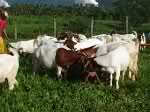 Goats can be reared in the pasteurland, but rearing them in cages has more advantages such as:
Goats can be reared in the pasteurland, but rearing them in cages has more advantages such as:
1. Cage-reared goats are less exposed to parasites.
2. They are better fed, and so the mother goat gives more milk.
3. Less field space is necessary for growing fodder and grass. For every six (6) females and one male goat, one-fourth (1/4) hectare of land would be enough.
4. The caged goats are easier tended and controlled.
However, more capital is necessary, and needs a worker to gather fodder to feed the goats and clean the cages. As preparation for the pasteur, plant such grasses and plants that the goats will need, like paragrass, napier, madre de cacao (kakawate), alibangbang and ipil-ipil. Apply as fertilizer for these plants the dried goat manure so as to make them flourish.
Cage
1. Wooden house, bamboo floor, with roof and open sides.
2. The floor is about 1.5 meters high from the ground so as to facilitate cleaning the manure.
3. At the sides of the house, provide food and drinking water.
4. Provide space outside to allow roaming around.
5. The nursing mothers and the weaning kids should have a separate house. One side must have a divider to separate the small ones from the mother at night.
6. Six (6) male goats are housed together.
Food
1. The aforementioned plants are feed for goats.
2. Don’t give too much for each meal, of fresh forage.
3. Goats don’t like dirty grass or acidic (spoiled) food.
4. They like variety of grasses for each meal.
Breeding
1. When the goats are about 6-8 months old, select good breeder and milker females and aggressive males.
2. A female goat may be mated at age 10-12 months. A male goat is ready to mate at age12 months. At the start, let him mate only a few, but as it grows older, the male goat can mate as many as 25 at age one and a half years.
3. A female goat’s fertile period lasts 2-3 days. The signs are:
- it begins to bleat (me-e-eh) and wags its tail.
- it urinates often.
- the genital is inflamed and secretes mucous
- the goat rides on other goats.
4. Mating should be once in the morning and once in the afternoon, and repeat next morning to be sure that there was fertilization.
5. Then separate the mated females. These will be pregnant in three (3) weeks if they won’t manifest flirting.
Parturition (Delivery)
1. The goat’s gestation period is 145-155 days. Thus, the day of mating should be recorded.
2. When the time of delivery is near, the mother goat bleats (cries me-e-eh), discharges mucous from the genital, is cranky and scratches her bed.
3. At delivery, her mucous discharge is yellowish.
4. When the kid is coming out of its mother, help the delivery by pulling out the kid, but make sure that the hands of the helper are clean. Apply alcohol on the hands to avoid infection. Normally, the head comes out first. The kids are often two, rarely three.
5. Wipe the nose of the newly born kid to enable it to breathe freely.
6. Apply iodine at the end of the umbilical cord, and put a knot or tie it.
7. When the kids are four (4) days old, remove the newly growing horns to keep them from hurting one another. Only a veterinarian or one with experience should undertake this.
8. Others are: putting of mark on the ear one week after birth; cut off the nails once a month, and castration from one to four months old.
Milking
1. Milk the mother goat five (5) days after delivery. Continue milking up to 3-5 months until the kids are weaned, or 60 days before another delivery.
2. Milk the goat in the early morning before the kids suck.
3. If the mother goat has abundant milk, she can be milked again toward afternoon.
4. Give the mother goat 200 to 300 gm concentrate daily to increase her milk.
Weaning
If the goat is raised to milk, do not totally wean the kid from the mother when this is 3-5 days old. Separate the kid from the mother at night.
If milk production is only secondary, separate the kid totally when this is 3 months old. Make sure the kids are fed and given water while they are separated from the mother. In this way, the kids will quickly learn to eat and drink even while still young.
Care
1. Allow the goats to exercise themselves 3-4 hours outside their cage.
2. Give them regular vaccination against disease.
3. Separate the sick and call for a veterinarian.
The common sicknesses of the goat are pneumonia and parasites.
Pneumonia:
Usually affects the goat with the onset and toward the end of the rainy season. Don’t allow them to be exposed to rain or draft. Signs of pneumonia are difficult and fast breathing.
Give the goat liquamycin, Tylan 200 or Combiotic injection.
Parasites:
Give the goat tetrazole or thixbenzole every six months.
Source: Greenfields Jan & Feb 1990 & PCARRD Farmers Dec 1986
Photo: alaminosgoatfarm.com
Source: Business Diary Philippines



0 Comments